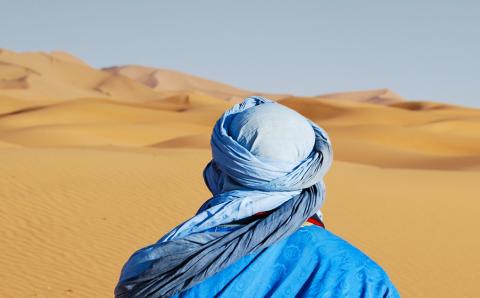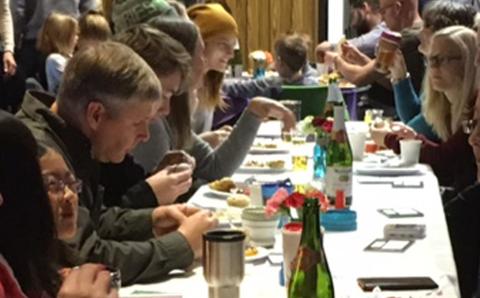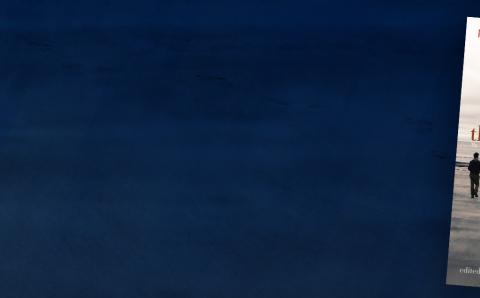The first time I looked for them, I had more than a little trouble. Let’s be clear—Morton, Minn., is no metropolis. Like a thousand other burgs in the Upper Midwest, its population losses have been the big story for a century already. Really tall monuments shouldn’t have been all that difficult to spot in a town that small.
But I couldn’t find them, even though I drove down every last street and avenue, looking. Nothing.
I did find a museum. Someone there, I thought, had to know where I could find Morton’s Dakota War monuments; after all, the docents were even older than I was. They had to know local history.
Nope. They didn’t seem to know what I was looking for.
Maybe I’d asked the question wrong. Maybe they didn’t understand my stuttering descriptions. Even those seniors didn’t appear to know what I was talking about.
I got back in the car and told myself those monuments had to be standing somewhere, because I’d read they overlooked the Minnesota River. Finally, a weathered sign pointed up a gravel road that wound through old hardwoods, ever-narrowing as I ascended the bluff. And there they were—two towering cement obelisks, out of view from the town below.
I wasn’t the first to go up there; the monuments are over a century old, after all. And there’d been recent visitors—kids, I’m guessing, from the bottles and cans beneath fallen tree branches and a thick scattering leaves. Things up the hill weren’t at all kept up. Two tall war monuments were not only hidden but largely forgotten, or so it seemed to me.
Now, you could argue that in the neighborhood of the Dakota War of 1862, people would just as soon forget all that killing. That war took the lives of hundreds of people on both sides and resulted in the largest mass hanging in American history—38 Dakota warriors on massive gallows in late December, just up the river in Mankato. Maybe it seemed best not to talk about the whole horrifying business, even though 150 years have already gone by.
And also not talk about the monuments themselves, for these towering memorials were created to honor specific participants in that war: “Erected in 1899 by the Minnesota River Historical Society,” one of them boldly states, “to commemorate the brave, faithful, and humane conduct of the loyal Indians who saved the lives of white people. . . .”
The story sounds selfless and heroic. But it’s probably fair to say that today few of the Dakota who still live in and around the valley would care a great deal about cleaning up around that particular monument. After all, at the very moment those celebrated Dakota men saved the lives of white people, they walked away from their own. Several of the men whose names are listed beneath the etched tribute played significant roles in freeing the prisoners of Dakota bands who had slaughtered as many as 500 pioneer Minnesotans—and held many hostages—107 whites and 162 mixed-bloods, 269 prisoners in total.
From the outset, the Dakota men memorialized on that monument had opposed the war that slaughtered so many on both sides. For a decade or more before the war, they’d begun to leave their own culture and assimilate into what would soon become the majority culture of white pioneers streaming onto what had been Dakota land. Several of the men were converts to the Christian religion—they were Christian Indians.
Praise the Lord—right? Yes, but before you stand up and sing, remember: there are people listening who are not lifting their hands and saying amen.
The area atop the bluff was cleaned up the next time I visited, a few years later, at a time when Minnesota had begun to revisit the 150th anniversary of its own civil war. Still, to most people—Native and Anglo—that particular Morton monument creates discomfort and makes the Christian faith and Christian missions particularly difficult to discuss.
The Dakota warriors who fought—were they savages or freedom fighters? And those who sided with the whites, those Christians—were they heroes or part of a Judas band? Who gets to define terms? Who gets to answer those questions?
Diane Glancy, a Cherokee poet and novelist, and a Christian, told me that in the gatherings and conferences she attends as a Native writer, the topic that’s most difficult to talk about is the Christian faith. No themes create such angry divisions.
Why? Because this country’s First Nations had trouble determining the difference between missionaries and militia. Everything seemed part of a way of life carried along by white folks flowing endlessly into their worlds, taking up residence as if the original inhabitants were invisible. These new people dressed strangely, cut their hair in an odd way, disciplined their children in manners some Native parents thought obscene, and prayed, oddly enough, without pipes or sweat lodges. That strange life was putting Dakota lives and cultures at risk, taking apart every vestige of a way of life that had given them breath. “Bending the knee” was not so much a spiritual as a cultural posture.
Good people, I’m sure—some Christians, some not, some Native, some white—would just as soon leave a monument to Christian Indians behind the trees and out of view. Some see saints in the names etched into the stone; others traitors. Both views, like it or not, are wholly understandable.
In the introduction to Dakota Cross-Bearer: The Life and Times of a Native American Bishop, Father Raymond A. Bucko remembers the funeral of a Lakota spiritual leader named Frank Fools Crow. The ceremony brought hundreds of Pine Ridge folks together to celebrate the life of a beloved man. Two groups formed at St. Barnabas Episcopal cemetery, Bucko remembers. At one end, Christian clergy in clerical collars, several of them Native, observed the ceremony; at the other, equally attentive, stood traditional spiritual leaders in feathered headdresses.
News crews covered the event. What Father Bucko remembers is that the video cameras shot the traditional Native spiritualists exclusively, keeping their backs to the Christian clergy.
“In the nineteenth century, the cameras could well have pointed in the other direction,” Bucko wrote, “focusing only on the Christianized Indians.” Not so today. Not so at the funeral of Fools Crow. “Rarely,” he says, “have the two realities been integrated into a single picture.” Rarely do Christianity and Native identity occupy important places in the same sentence.
Make no mistake; Christ’s final injunction to his people is no less current, no less a calling than it ever was: “Go ye into all the world and preach the gospel.” As we know, however, sometimes the gospel may be more vividly expressed in silence, in tolerance and goodwill, in a simple ministry of presence.
The divide between can be a shame for many reasons, one of which means we’re kept from remembering the stories of the men whose names are on the monument. Some of those stories beg to be told.
What’s more, the contributions of Christian missions to Native life are very real. Some are frightful. Horror and bigotry and brutality were all carried along by some who claimed to be wielding Christ’s love. The man who might be considered central to the Great Sioux Wars of the 19th century, the barrel-chested Col. John Chivington, whose volunteer Colorado cavalry massacred Cheyenne and Arapaho people at Sand Creek, is often referred to as “a Calvinist preacher.”
Still, what those video cameras miss when they don’t show the Christian missionaries is a story that begs to be told—maybe, today, only in hushed tones.
The Osage people suffered immensely during the 1850s and 60s. Disease, much of it spread by contact with whites, devastated the people, in part because they were forced to live in clusters in which contagion flourished. Living where they were in southeast Kansas put them in the middle of the bloody attacks carried on between slave-owners and free men after the Kansas-Nebraska Act. Life itself was deadly.
In A History of the Osage People (2004), Louis Burns, himself Osage, claims that three factors basically saved the people. “These were Andrew J. Dorn, their agent; the Jesuits; and the school at Osage Mission.” Dorn, a tribal agent, was a good man in a job frequently filled by crooks. The Jesuits were the missionaries, and the Osage Mission was the school they created. “These three factors,” Burns wrote, “were the counterbalance that saved the Osages from extinction in this period.”
John P. Williamson, a Presbyterian missionary to the Santee/Dakota people of Minnesota, stayed with the vanquished warriors who weren’t hung at Mankato in December of 1862— stayed with them through three-year imprisonments, ministered to them when hate was as poisonous as it was overwhelming, hate that came even from fellow clergy. Williamson was attacked, physically, for continuing to worship with the imprisoned Lakota. “Holiest rites of the church given to red-handed murderers,” one journalist wrote. “God was mocked.”
Today, that story, like the Morton monument, may well be better kept beneath the trees and fallen branches.
There’s more. Father John Schoenmakers, a Dutch-born Jesuit, was one of those clergy Louis Burns credits with holding together the life of the Osage people in the mid-19th century. On the night of August 11, 1875, Schoenmakers fell gravely ill, even though he was attended by the agency doctor. The Osage people, sensing death, crowded around him in the infirmary. When the doctor told them to leave, they threatened to scalp the doctor if Schoenmaker died.
So he bargained a compromise. Two Osage warriors were stationed at Schoenmaker’s bedside to watch closely while the doctor treated the priest they so loved. Special tribal guards stayed with him night and day until he was healthy enough to leave his bed. A decade later, when the beloved priest died, 3,500 people attended his funeral.
The story goes that once upon a time, not long ago, one of our own missionaries to Native people gave a guided tour to long-time mission supporters. When he did, he talked about the mission itself, as well as the tribe and problems endemic to all Native reserves and reservations—unemployment, poverty, alcoholism, and family dysfunction. When the long-time mission supporters put their interview up on social media, some Native people discovered the conversation and weren’t happy. They were, understandably, angry.
Forgiveness is always in order, but in this case, understanding how what was said felt like insult and prejudice is greatly helpful to those of us who don’t understand and have little knowledge of Native life—as it was or as it is today.
Because prejudice is not behind us. Recently, my home town dedicated a new veterans’ memorial downtown. Etched in the onyx walls are sketches and numbers—pictorial references to the wars this country has fought, along with the names of those who gave “the supreme sacrifice.” The memorial is brand new, and the community is proud of the honors it bestows on those who gave their lives.
One of the plates is given to the Indian wars, and the tally is an estimate—1,000 dead Americans. But who can possibly deny that there weren’t hundreds of thousands more, the original Americans, the First Nations, the aboriginal people, who died in all those wars—from Block Island in Massachusetts to Temecula, California?
Not to consider Native Americans as Americans is more than embarrassing, isn’t it? Just like that tall monument above the town of Morton and the valley of the Minnesota River, there’s so much more to the story, more that needs be said.
Permit me to tell just one more story. Gall was no giant, but he must have been built like a grand piano. General Custer's wife, Libby, once gushed that she had never "dreamed there could be in all the tribes so fine a specimen of a warrior as Gall."
When Gall stood to speak against the Fort Laramie Treaty, he showed the Peace Commission the museum of scars he'd picked up in countless fights, a testimony and a warning.
Six years later, along with his friend Sitting Bull, Gall and his people took a place along the banks of the Little Big Horn and then rode fiercely in the middle of the bloodletting. Gall rode as an Indian fighting for freedom, but also to avenge the deaths of two of his wives and children.
After Little Big Horn, Gall and his people went north to Canada, where they stayed for four years until conflicts with other Native tribes arose, much of it attributable to poverty. Weary and homesick, Gall and his people left Canada in 1881 and surrendered in Montana.
One Sunday, on his horse, Gall was riding slowly by St. Elizabeth's, the mother church of all the Episcopal churches on the Standing Rock Reservation, when from inside came the distinctive and beautiful sound of a hymn, music he had never heard before. He stopped and listened, almost transfixed. That moment, some say, was the first step on the road to his being adopted into the Christian faith.
Just that fast, just that quickly. From outside, what he heard through that open door was a hymn I’m sure most of us know, some of us by heart: "Guide Me, O Thou Great Jehovah."
That’s a story hard to keep under fallen branches. Next time you sing that hymn, think of Gall, out at Standing Rock, on his horse, in a kind of bewonderment.
Let those who have ears, listen.
About the Author
James C. Schaap is a writer who lives in Sioux Center, Iowa.









